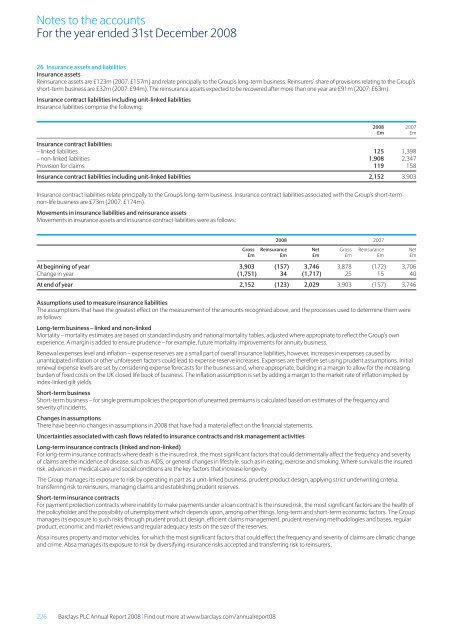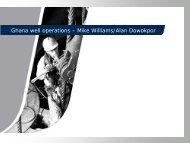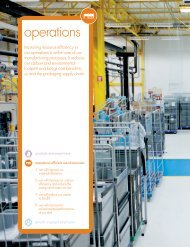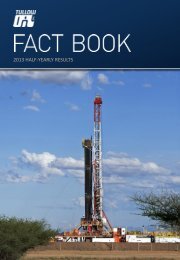Barclays plc - Annual Report 2008 - Financial statements - The Group
Barclays plc - Annual Report 2008 - Financial statements - The Group
Barclays plc - Annual Report 2008 - Financial statements - The Group
You also want an ePaper? Increase the reach of your titles
YUMPU automatically turns print PDFs into web optimized ePapers that Google loves.
Notes to the accounts<br />
For the year ended 31st December <strong>2008</strong><br />
26 Insurance assets and liabilities<br />
Insurance assets<br />
Reinsurance assets are £123m (2007: £157m) and relate principally to the <strong>Group</strong>’s long-term business. Reinsurers’ share of provisions relating to the <strong>Group</strong>’s<br />
short-term business are £32m (2007: £94m). <strong>The</strong> reinsurance assets expected to be recovered after more than one year are £91m (2007: £63m).<br />
Insurance contract liabilities including unit-linked liabilities<br />
Insurance liabilities comprise the following:<br />
<strong>2008</strong> 2007<br />
£m £m<br />
Insurance contract liabilities:<br />
– linked liabilities 125 1,398<br />
– non-linked liabilities 1,908 2,347<br />
Provision for claims 119 158<br />
Insurance contract liabilities including unit-linked liabilities 2,152 3,903<br />
Insurance contract liabilities relate principally to the <strong>Group</strong>’s long-term business. Insurance contract liabilities associated with the <strong>Group</strong>’s short-term<br />
non-life business are £73m (2007: £174m).<br />
Movements in insurance liabilities and reinsurance assets<br />
Movements in insurance assets and insurance contract liabilities were as follows:<br />
<strong>2008</strong> 2007<br />
Gross Reinsurance Net Gross Reinsurance Net<br />
£m £m £m £m £m £m<br />
At beginning of year 3,903 (157) 3,746 3,878 (172) 3,706<br />
Change in year (1,751) 34 (1,717) 25 15 40<br />
At end of year 2,152 (123) 2,029 3,903 (157) 3,746<br />
Assumptions used to measure insurance liabilities<br />
<strong>The</strong> assumptions that have the greatest effect on the measurement of the amounts recognised above, and the processes used to determine them were<br />
as follows:<br />
Long-term business – linked and non-linked<br />
Mortality – mortality estimates are based on standard industry and national mortality tables, adjusted where appropriate to reflect the <strong>Group</strong>’s own<br />
experience. A margin is added to ensure prudence – for example, future mortality improvements for annuity business.<br />
Renewal expenses level and inflation – expense reserves are a small part of overall insurance liabilities, however, increases in expenses caused by<br />
unanticipated inflation or other unforeseen factors could lead to expense reserve increases. Expenses are therefore set using prudent assumptions. Initial<br />
renewal expense levels are set by considering expense forecasts for the business and, where appropriate, building in a margin to allow for the increasing<br />
burden of fixed costs on the UK closed life book of business. <strong>The</strong> inflation assumption is set by adding a margin to the market rate of inflation implied by<br />
index-linked gilt yields.<br />
Short-term business<br />
Short-term business – for single premium policies the proportion of unearned premiums is calculated based on estimates of the frequency and<br />
severity of incidents.<br />
Changes in assumptions<br />
<strong>The</strong>re have been no changes in assumptions in <strong>2008</strong> that have had a material effect on the financial <strong>statements</strong>.<br />
Uncertainties associated with cash flows related to insurance contracts and risk management activities<br />
Long-term insurance contracts (linked and non-linked)<br />
For long-term insurance contracts where death is the insured risk, the most significant factors that could detrimentally affect the frequency and severity<br />
of claims are the incidence of disease, such as AIDS, or general changes in lifestyle, such as in eating, exercise and smoking. Where survival is the insured<br />
risk, advances in medical care and social conditions are the key factors that increase longevity.<br />
<strong>The</strong> <strong>Group</strong> manages its exposure to risk by operating in part as a unit-linked business, prudent product design, applying strict underwriting criteria,<br />
transferring risk to reinsurers, managing claims and establishing prudent reserves.<br />
Short-term insurance contracts<br />
For payment protection contracts where inability to make payments under a loan contract is the insured risk, the most significant factors are the health of<br />
the policyholder and the possibility of unemployment which depends upon, among other things, long-term and short-term economic factors. <strong>The</strong> <strong>Group</strong><br />
manages its exposure to such risks through prudent product design, efficient claims management, prudent reserving methodologies and bases, regular<br />
product, economic and market reviews and regular adequacy tests on the size of the reserves.<br />
Absa insures property and motor vehicles, for which the most significant factors that could effect the frequency and severity of claims are climatic change<br />
and crime. Absa manages its exposure to risk by diversifying insurance risks accepted and transferring risk to reinsurers.<br />
226 <strong>Barclays</strong> PLC <strong>Annual</strong> <strong>Report</strong> <strong>2008</strong> | Find out more at www.barclays.com/annualreport08

















